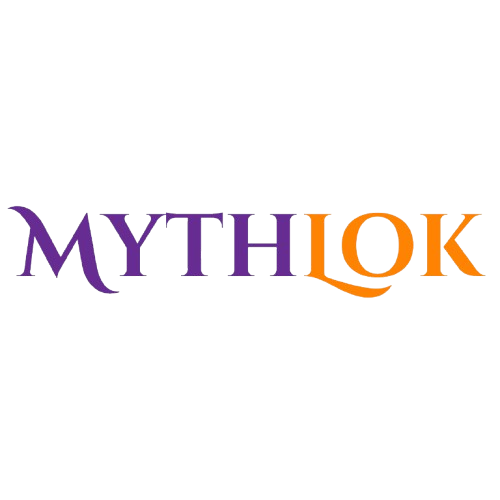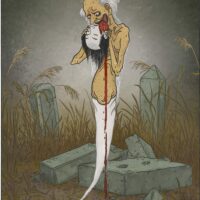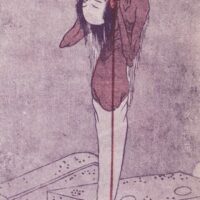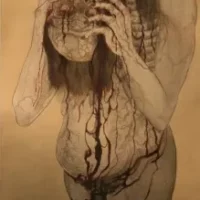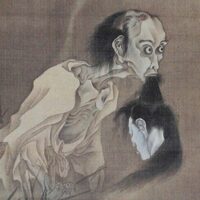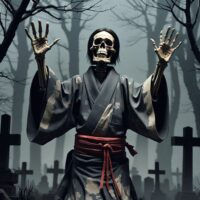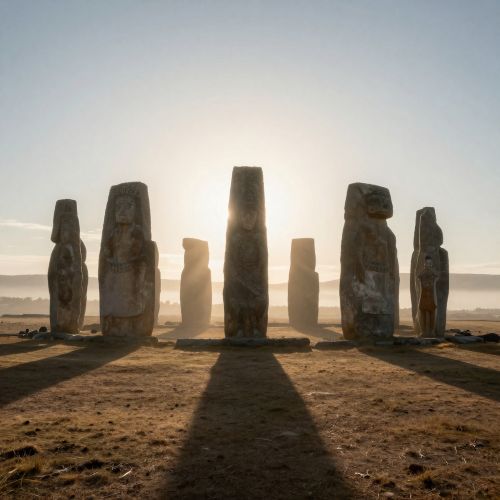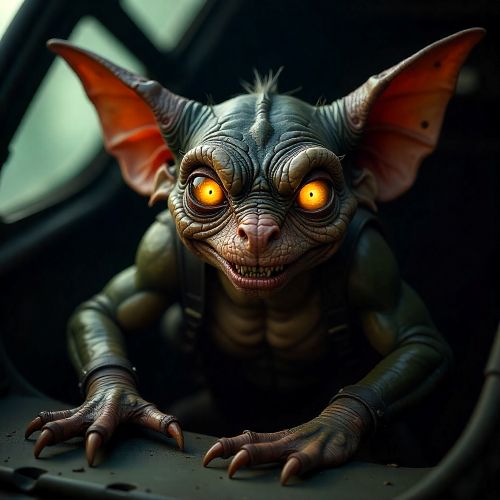Kubikajiri : The Graveyard Head-Biter
Listen
At a glance
| Description | |
|---|---|
| Origin | Japanese Mythology |
| Classification | Ghosts |
| Family Members | N/A |
| Region | Japan |
| Associated With | Graveyards, Death |
Kubikaijri
Introduction
In the vast tapestry of Japanese mythology, a pantheon of creatures and spirits each boasts unique characteristics and tales. Among these enigmatic entities is the Kubikajiri, a ghostly figure with a macabre inclination. The name “Kubikajiri” translates to “Head Eater” in English, hinting at its eerie and unsettling nature. This specter is primarily associated with graveyards, where it is said to roam in search of human heads to devour. Although the Kubikajiri is relatively lesser-known compared to famous Japanese spirits like the Yurei or the Oni, its legend is no less fascinating or terrifying.
In the shadowy corners of Japanese folklore lurk a multitude of yōkai, supernatural creatures ranging from mischievous pranksters to terrifying devourers. Among these chilling entities is the Kubikajiri, a ghastly apparition driven by a gruesome hunger. This ghost haunts graveyards under the cover of night, marked by the unmistakable scent of fresh blood. What makes this spectral entity truly chilling is its insatiable hunger for heads—whether they belong to the living or the deceased.
Physical Traits
The Kubikajiri is a ghastly figure known for its headless appearance. Often depicted as an emaciated, skeletal form clad in tattered clothing, it roams silently through burial grounds. Long, disheveled hair, sometimes matted with blood, hangs from its neck, emphasizing its horrific visage. If it has eyes, they are sunken and vacant, peering out from where its head should be. The stench of fresh blood heralds its approach, serving as a chilling olfactory warning.
Imagine an old man draped in white burial shrouds, his face obscured by darkness. His gaunt figure moves with purpose, driven by an otherworldly compulsion. Common descriptions of the Kubikajiri include a ghostly, pale complexion and an ethereal form that seems to float or hover above the ground. Despite retaining a humanoid shape, it often features distorted and unsettling characteristics such as hollow eyes and a gaping mouth perpetually fixed in a grotesque grin.
A distinctive trait of the Kubikajiri is its fixation on human heads. In some stories, it carries a severed head, while in others, its own head may appear disjointed or partially detached, highlighting its gruesome obsession. Encountering a Kubikajiri is deeply unnerving, often accompanied by an aura of coldness and a feeling of impending doom.
Family
The concept of “family” for a spirit like the Kubikajiri is more abstract compared to that of living beings. In the broader context of Japanese mythology, it belongs to the larger “family” of yurei and yokai. Yurei are spirits of the dead who have not found peace, often due to violent or traumatic deaths, while yokai are a diverse group of supernatural creatures inhabiting Japanese folklore. The Kubikajiri shares commonalities with other spirits driven by strong, lingering emotions such as revenge, hunger, or unfulfilled desires. This connection places it within a broader mythological framework, interacting with other spectral entities in Japanese ghost stories.
Unlike some yokai with complex hierarchies or family structures, the Kubikajiri appears to be a solitary creature. Legends offer no tales of packs hunting together or interactions with other supernatural beings. Driven by a singular, insatiable hunger, the Kubikajiri roams graveyards alone, a spectral outcast in the realm of the dead. It seeks no companionship or kinship, existing solely to fulfill its gruesome quest for heads. Severed from any earthly ties, it wanders in isolation.
Other names
The name “Kubikajiri” translates literally to “head-biter,” clearly indicating the creature’s gruesome purpose. However, regional variations exist. In some areas, it may be referred to as “Kubikui” (首食い), which also means “head-eater,” emphasizing its act of consumption. Alongside “Kubikajiri,” it is known by other names and titles in various regional legends and folklore. Some call it the “Kubi-gami,” or “Head God,” although this term is less common. These variations in names reflect local interpretations and characteristics attributed to the spirit, illustrating how folklore can evolve across different cultural contexts while preserving its core essence.
Powers and Abilities
The Kubikajiri is endowed with a potent arsenal of supernatural abilities that amplify its terrifying presence in Japanese folklore. Despite its skeletal frame, this spectral entity is said to possess superhuman strength, enabling it to overpower its victims effortlessly. Legends recount its ability to phase through solid objects, rendering conventional containment futile and escape virtually impossible once it sets its sights on prey. Some tales even speak of the Kubikajiri’s invisibility, further enhancing the fear it evokes by allowing it to move undetected among the living and the deceased alike.
Beyond its physical prowess, the Kubikajiri is described as possessing enhanced senses that aid its grisly pursuits. Despite lacking conventional sight, it is rumored to have a keen olfactory sense, particularly attuned to the scent of fresh blood. This acute sense guides the Kubikajiri unerringly to its victims, often found in graveyards where it roams in search of heads to consume. These abilities collectively make the Kubikajiri a formidable and relentless predator within the realm of Japanese ghost lore, instilling dread and fear into those who hear tales of its haunting presence.
The origins of the Kubikajiri remain enigmatic, with various theories attempting to illuminate its emergence. One compelling hypothesis traces its roots to a painting by the artist Ippitsusai Bunchō. This artwork depicts a spectral figure devouring a head within a graveyard, potentially serving as the catalyst for the legend to take shape and evolve into a distinct yōkai over time.
Another interpretation delves into Japan’s historical hardships, particularly during periods of famine or economic distress. It is suggested that societal anxieties surrounding neglect and abandonment of the elderly and infirm could have contributed to the Kubikajiri myth. This chilling narrative posits the Kubikajiri as a ghostly manifestation born from the fear and guilt associated with those who died alone and forgotten, haunting the collective consciousness as a poignant reminder of past societal injustices.
Modern Day Influence
The legend of the Kubikajiri, despite its ancient origins, exerts a profound influence on modern Japanese culture across various forms of media. In contemporary horror literature, films, and manga, the Kubikajiri’s eerie attributes are often exaggerated for dramatic impact. It serves as a potent symbol of death and the supernatural, inspiring modern storytellers to explore themes of fear and mortality. These narratives frequently caution against disturbing graves or disrespecting the dead, resonating with audiences through their timeless themes of the unknown and consequences.
In cinema and television, the Kubikajiri makes appearances in horror films and shows, where its unsettling nature is vividly brought to life through special effects and storytelling techniques. Its ghostly appearance and macabre habit of consuming human heads create chilling and visceral experiences for viewers. Manga and anime also feature the Kubikajiri, integrating it into fantastical narratives that blend traditional folklore with contemporary storytelling methods. Here, its abilities and characteristics are expanded upon, enriching its mythos and allowing for creative reinterpretations.
Beyond entertainment, the Kubikajiri’s legend permeates contemporary Japanese festivals and cultural events, sometimes featuring reenactments or references that highlight its role in shaping cultural identity. As a figure deeply embedded in Japanese pop culture, the Kubikajiri continues to captivate audiences with its grotesque visage and enduring themes of fear and caution.
Related Images
Frequently Asked Questions
What is lorem Ipsum?
I am text block. Click edit button to change this text. Lorem ipsum dolor sit amet, consectetur adipiscing elit. Ut elit tellus, luctus nec ullamcorper mattis, pulvinar dapibus leo.
What is lorem Ipsum?
I am text block. Click edit button to change this text. Lorem ipsum dolor sit amet, consectetur adipiscing elit. Ut elit tellus, luctus nec ullamcorper mattis, pulvinar dapibus leo.
What is lorem Ipsum?
I am text block. Click edit button to change this text. Lorem ipsum dolor sit amet, consectetur adipiscing elit. Ut elit tellus, luctus nec ullamcorper mattis, pulvinar dapibus leo.
What is lorem Ipsum?
I am text block. Click edit button to change this text. Lorem ipsum dolor sit amet, consectetur adipiscing elit. Ut elit tellus, luctus nec ullamcorper mattis, pulvinar dapibus leo.
What is lorem Ipsum?
I am text block. Click edit button to change this text. Lorem ipsum dolor sit amet, consectetur adipiscing elit. Ut elit tellus, luctus nec ullamcorper mattis, pulvinar dapibus leo.

